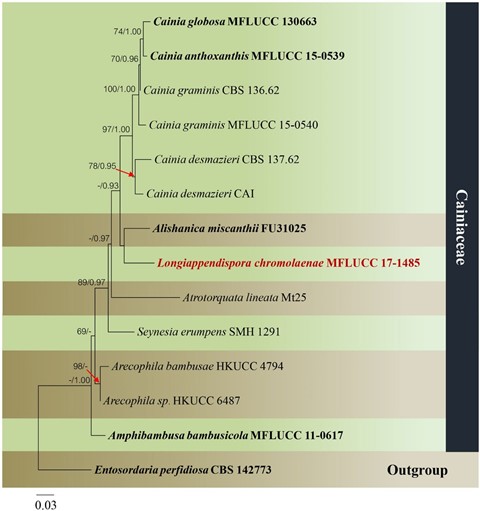Longiappendispora Mapook & K.D. Hyde, in Mapook, Hyde, McKenzie, Jones, Bhat, Jeewon, Stadler, Samarakoon, Malaithong, Tanunchai, Buscot, Wubet & Purahong, Fungal Diversity 101: 139 (2020)
Index Fungorum number: IF 557336, Facesoffungi number: FoF 07841
Etymology – The generic epithet reflects the ascospores with long bristle-like polar appendages.
Saprobic on dead stems. Sexual morph: Ascomata immersed beneath clypeus, unilocular, globose to subglobose, coriaceous, solitary or scattered, or sometimes gregarious. Ostiole central. Peridium comprising 2–3 layers, pale brown to hyaline cells of textura angularis. Hamathecium composed of cylindrical to broadly filiform, septate, guttulate, hyaline paraphyses, embedded in a gelatinous matrix. Asci 8-spored, unitunicate, cylindrical to broadly filiform, short-pedicellate, straight or slightly curved, with an apical ring, apically rounded. Ascospores uniseriate, hyaline when immature, becoming brown to dark brown when mature, 1-septate, ellipsoid to broadly fusiform, tapering towards narrow ends, constricted at the septum, straight or slightly curved, guttulate at both cells, with longitudinal striations and bristle-like polar appendages from both ends, without a gelatinous sheath. Asexual morph: Undetermined.
Type species – Longiappendispora chromolaenae Mapook & K.D. Hyde
Notes – A phylogenetic analysis based on combined dataset of the ITS and LSU sequence data show that Longiappendispora chromolaenae groups with a new genus, Alishanica miscanthii (FU 31025), with low bootstrap support in Cainiaceae and clusters with Cainia clade (0.93 BYPP, Fig. 127). However, Longiappendispora species differ from Alishanica by larger ascomata (500–580 × 360–505 µm vs. 277–272 × 288–285 µm), a thin peridium wall [(15–)20–30 µm vs. 52–60 µm], narrower asci (140–230 × 13–20 µm vs. 173–179 × 23–31 µm) and smaller ascospores (28.5–43 × 9.5–12 µm vs. 59–62 × 19–21 µm) with bristle-like polar appendages on both ends of the ascospores and without a gelatinous sheath (Table 29). Therefore, we introduce Longiappendispora as a new genus with a new species L. chromolaenae, based on morphological comparison with phylogenetic analyses. A comparison of the ITS (+5.8S) gene region of L. chromolaenae and Alishanica miscanthii reveals 78 base pair differences (17.9%) across 435 nucleotides.

Fig. 127 Phylogram generated from maximum likelihood anal- ysis based on combined dataset of ITS and LSU sequence data. Fourteen strains are included in the combined sequence analysis, which comprise 1506 characters with gaps. The best scoring RAxML tree with a final likeli- hood value of − 4717.509202
is presented. The matrix had 329 distinct alignment pat- terns, with 22.49% of unde- termined characters or gaps. Estimated base frequencies were as follows: A = 0.255033, C = 0.233739, G = 0.280548, T = 0.230680; substitution rates: AC = 2.006227, AG = 2.877479, AT = 3.211990, CG = 2.743197, CT = 8.119404, GT = 1.000000; gamma distribution shape parameter α = 0.202825. Boot- strap support values for ML equal to or greater than 60% and BYPP equal to or greater than
0.90 are given above the nodes. Newly generated sequences are in dark red bold and type spe- cies are in bold. Entosordaria perfidiosa (CBS 142773) is used as outgroup taxon
Table 29 Morphological features of species in Cainiaceae discussed in this study
| Species | Asocomata (µm) | Peridium (µm) | Asci (µm) | Ascospores (µm) | Morphology of | References |
| Longiappendis- pora chromolae- nae (MFLUCC 17-1485)
|
500–580 high × 360–505 diam. | (15–)20–30 | 140–230 × 13–20 | 28.5–43 × 9.5–12 | With longitudinal striations and bristle-like polar appendages from both ends, without gelatinous sheath | This study |
| Alishanica miscanthii
(FU 31025)
|
277–272 high × 288–285 diam. | 52–60 | 173–179×23–31 | 59–62×19–21 | With striations, surrounded by a thick, hyaline mucilaginous sheath sub globose, parallel to the margin of the spore | Hyde et al. (2020) |
Species
